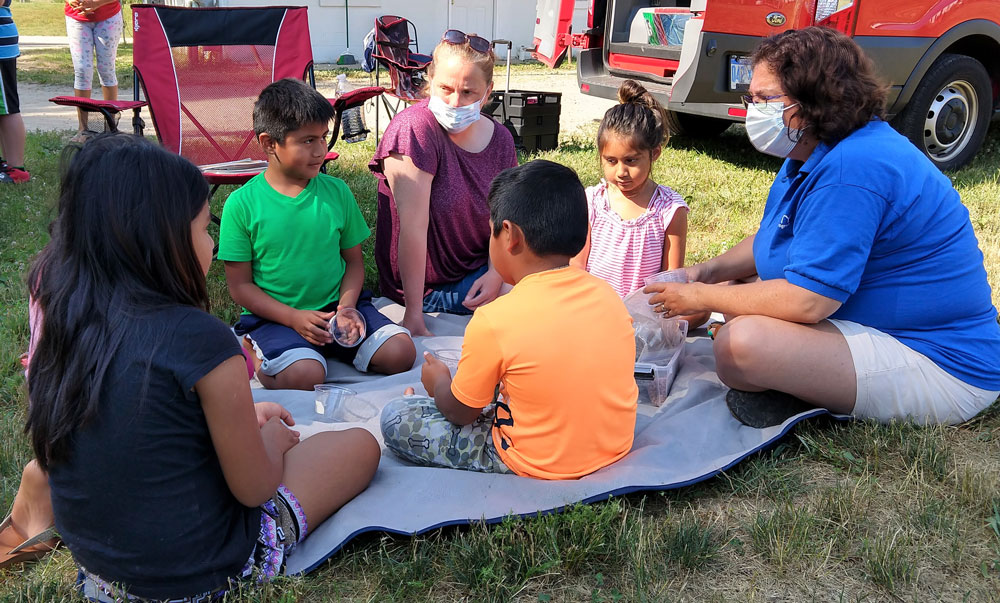Despite the challenges of bringing in equipment and supplies, and teaching outside in 90-degree temperatures, “This year was by far the most special,” said teacher Ashley Wojtas.
She credits staff, interpreters and Program Director Jeremy Smith for making sure the migrant education program continued.
“In a normal summer we would have students at our middle school building for several hours per day,” Smith said. “ With COVID, that was no longer possible. We decided that the best course of action would be to take our program to the students.”
The plan called for four teaching teams, made up of two teachers and two aides, to visit two or more migrant camps each day on a rotating schedule. In all, the teams would visit more than 20 migrant camps each week. Instruction centered around reading and math lessons with a science theme.
“We gloved up, masked up, washed up, and we made a difference –and that is what this program is all about.”
– Ashley Wojtas, teacher, summer migrant education program
According to the Michigan Department of Education, the Michigan migrant program’s purpose is to “support high quality comprehensive educational programming for migratory children, designed to help reduce the educational disruptions and other problems that result from repeated moves.”
“I believe that we really made progress this summer, proving anything is possible when it comes to educating kids,” said Wojtas, who has been with the program for more than a decade.
The local program serves several districts in the summer, including Kent City, Sparta, Kenowa Hills, Coopserville, Ravenna and a portion of Fruitport.
Also over the summer, more than 2,000 lunches from the district’s food service department were served, and more than 300 vegetable and fruit boxes were distributed through the Farmers to Families project.

Outdoor Classrooms
Over 170 migrant students were registered in the program this summer. Teams set up for classes every day with canopy tents, materials, tables and lawn blankets.
The first priority was safety of staff and students, Smith said. Staff were trained in safety procedures and required to wear face masks while working with students. Instruction occurred outdoors.
“Not that it was always easy to teach outdoors,” Smith said. “Our first week during July it averaged over 90 degrees each day. Fortunately it did cool off after that.”
Other challenges were rain, dust, wind and bugs. But teaching outside also brought positives.
“We were able to use the environment when we taught about living and nonliving things, and take a walk around outside pointing to objects and having students respond,” Smith said. “We also studied the parts of plants and could use the apple trees or blueberry bushes that were only 20 feet away.”

Other teachers pointed to how being at the camps made it easier to adapt to smaller class sizes, allowing them to focus instruction in a more personalized way for individual students.
“With the long break due to school closing, students were more eager to see their teachers,” Smith said.
Wojtas said many students return year after year, even if sometimes they are placed in different camps.
“I had one family with a kindergartener this year, whose son was with us when he graduated and went to Michigan State,” she said. “It is so rewarding to hear about big brothers or sisters whom we’ve had before.”
Hearing how her former student was doing was particularly interesting in this case, she said, since many children choose to remain in a migratory lifestyle as opposed to moving into a college setting.

Very Special Family Night
Veteran teachers noted that going to homes helped make more connections, both with students and their families.
“Just knocking on their doors and being a part of the migrant culture offered a unique opportunity,” Wotjas said. “It really made a difference in how we approached some subjects.”
And in how district staffers interact with families. Case in point: the annual family night, which celebrates the end of summer instruction.
In past years, students, families and staff gathered at Kent City Middle School over a meal, music and a highlight video. “But this summer we brought the meals to our families,” Smith said.
Staff split into teams of four and delivered over 300 meals over two evenings. They also distributed household goods and literacy materials donated by staff.
“This made for two long days for staff, but I only heard good things about how it went,” Smith said.
Wotjas called it “a great connection with the parents.”
“This was really a great model for family night and we would love to do this again.”












